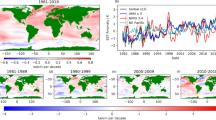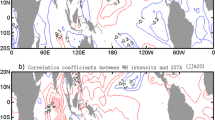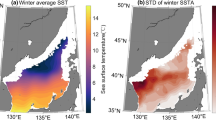Abstract
By using the TRMM and QuikSCAT datathe characteristics of the 2–8 day high frequency atmospheric variability over the South China Sea are studied in this paper. It’s found that: (1) the 2–8 day high frequency signals are significant not only during the periods of the South China Sea Summer Monsoon (SCSSM), but also after the retreat of the SCSSM. It reaches its peak around July to August; (2) the 2–8 day high frequency signals exhibit strong intermittent features; (3) During El Nino years, the 2–8 day high frequency signals are active only in the periods of the SCSSM. During La Nina years, the 2–8 day high frequency signals are obviously not only in periods of the SCSSM, but also after the retreat of the SCSSM. During the SCSSM periods, the 2–8 day high frequency signals in El Nino years are much stronger than that in La Nina years; (4) During spring to early summer, most of 2–8 day signals propagate southward and eastward, during midsummer to autumn, however, most of 2–8-day signals propagate northward and westward; (5) The 2–8 day northward and westward propagation signals is probably related to the activities of high-frequency vortex over the SCS.
Similar content being viewed by others
References
Chang C P. 2004. The East Asian monsoon. Singapore: World Scientific, 560
Chang C P, Chen G T J. 1995. Tropical circulations associated with southwest monsoon onset and westerly surges over the South China Sea. Mon Wea Rev, 123, 3254–3267
Chin T M, Milliff R F, Large W G. 1998. Basin-Scale High-Wavenumber Sea Surface Wind Fields from Multiresolution Analysis of Scatterometer Data, J Atmos Ocean Technology, 15: 741–763
Ding Y. 1994. Monsoons over China, Dordrecht Boston London: Kluwer Academic Publisher, 419
Ding Y, Chan J C L. 2005. The East Asian summer monsoon: an overview. Meteorol Atmos Phys, 89: 117–142
Ding Y, Li C, Liu Y. 2004: Overview of the South China Sea Monsoon Experiment. Adv Atmos Sci, 21: 343–360
Guo K, et al. 1996. Relationship of the short-period atmospheric oscillations with vortex activity and the precipitation in Shanxi, Journal of Chengdu institute of meteorology (in Chinese), 11: 246–252
Huffman G J. 1997. Estimates of Root-Mean-Square Random Error for Finite Samples of Estimated Precipitation, J Appl Meteor, 1191–1201
Huffman G J, Adler R F, Rudolph B, et al. 1995. Global Precipitation Estimates Based on a Technique for Combining Satellite-Based Estimates, Rain Gauge Analysis, and NWP Model Precipitation Information. J Clim, 8: 1284–1295
Hartmann D L, Michelsen M L. 1989. Intraseasonal periodicities in Indian rainfall. J Atmos Sci, 46: 2838–2862
Knutson T R, Weickmann K M. 1987: 30–60 day atmospheric oscillations: Composite life cycles of convection and circulation anomalies. Mon Wea Rev, 115: 1407–1436
Krishnamurti T N, Subrahmanyam D. 1982. The 30–50 day mode at 850 mb during MONEX. J Atmos Sci, 39: 2088–2095
Krishnamurti T N, Chakraborti D R, Cubukcu N, et al. 2003. A mechanism of the MaddenCJulian oscillation based on interactions in the frequency domain. Q J R Meteorol Soc, 129, 2559–2590
Lawrence D M, Webster P J. 2002. The boreal summer intraseasonal oscillations: Relationship between northward and eastward movement of convection. J Atmos Sci, 59: 1593–1606
Lau K M, et al. 2000. A report of the field operations and early results of the South China Sea Monsoon Experiment. Bull. Amer Meteor Soc, 81: 1261–1270
Li Xia, Liang Jianyin, Zheng Bin. 2007. Interdecadal Variabil ities of SCS Summer Monsoon Intensity. Chinese J Appl Meteor Sci(in Chinese), 18: 330–339
Mao J, Chan J C L. 2005. Intraseasonal Variability of the South China Sea Summer Monsoon. J Climate, 18: 2388–2402
Matthews A J, Kiladis G N. 1999. The tropicalextratropical interaction between high-frequency transients and the Madden-Julian oscillation. Mon Wea Rev, 127: 661–677
Milliff R F, Morzel J, Chelton D B, et al. 2004. Wind stress curl and wind stress divergence. biases from rain effects on QSCAT surface wind retrievals. J Atmos Ocean Tech, 21: 1216–1231
Qiao Y, Jian M, Luo H. 2002. Different characteristics of precipitation over four sub-regions of South China Sea during summer monsoon and the abrupt change. J Tropical Meteor(in Chinese), 18: 38–44
Serra Y L, Robert A. Houze Jr. 2002: Observations of Variability on Synoptic Timescales in the East Pacific ITCZ. J Atmos Sci, 59: 1723–1743
Sharp R J, et al. 2002. Early detection of tropical cyclones using seawinds-derived vorticity. Bull Amer Meteor Soc, 2002, 83, 879–889
Tao W K, Lang S, Olson W S, et al. 2001: Retrieved Vertical Profiles of Latent Heat Release Using TRMM Rainfall Products for February 1998. J Appl Meteorol, 40: 957–982
Vincent D G, Fink A, Schrage J M, et al. 1998. High and low frequency intraseasonal variance of OLR on annual and ENSO time scales. J Climate, 11: 968–986
Von Ahn J M, Sienkiewicz J M, Chang P S. 2006. The operational impact of QuikSCAT winds at the NOAA Ocean Prediction Center, Wea and Forecasting, 21: 523–539
Wang B, Lin Ho, Zhang Y, et al. 2004. Definition of South China Sea Monsoon Onset and Commencement of the East Asia Summer Monsoon. J Climate, 17: 699–710
Yang S, Smith E A. 1999a. Four Dimensional structure of monthly latent heating derived from SSM/I satellite measurements. J Climate, 12: 1016–1037
Yang S, Smith E A. 1999b: Moisture budget analysis of TOGA-COARE area using SSM/I retrieved latent heating and large scale Q2 estimates. J Atmospheric and Oceanic Technology, 16: 633–655
Zhou W, Chan J C L. 2007. ENSO and the South China Sea summer monsoon onset. Int J Climatol, 27: 157–167
Author information
Authors and Affiliations
Corresponding author
Additional information
Foundation item: The National Natural Science Foundation of China under contract No. 40875020, the National Basic Research Program of China under contract No. 2011CB403500 and the NSFC-Guangdong Joint Fund Program under contract No. U0733002.
Rights and permissions
About this article
Cite this article
Li, W., Wang, D., Lei, T. et al. High-frequency atmospheric variability over South China Sea as depicted by TRMM and QuikSCAT. Acta Oceanol. Sin. 30, 46–52 (2011). https://doi.org/10.1007/s13131-011-0104-9
Received:
Accepted:
Published:
Issue Date:
DOI: https://doi.org/10.1007/s13131-011-0104-9




